LINKSYS WUSB11V4 Wireless USB Network Adapter User Manual Book
LINKSYS LLC Wireless USB Network Adapter Book
LINKSYS >
Contents
- 1. Part 1
- 2. Part 2
Part 1
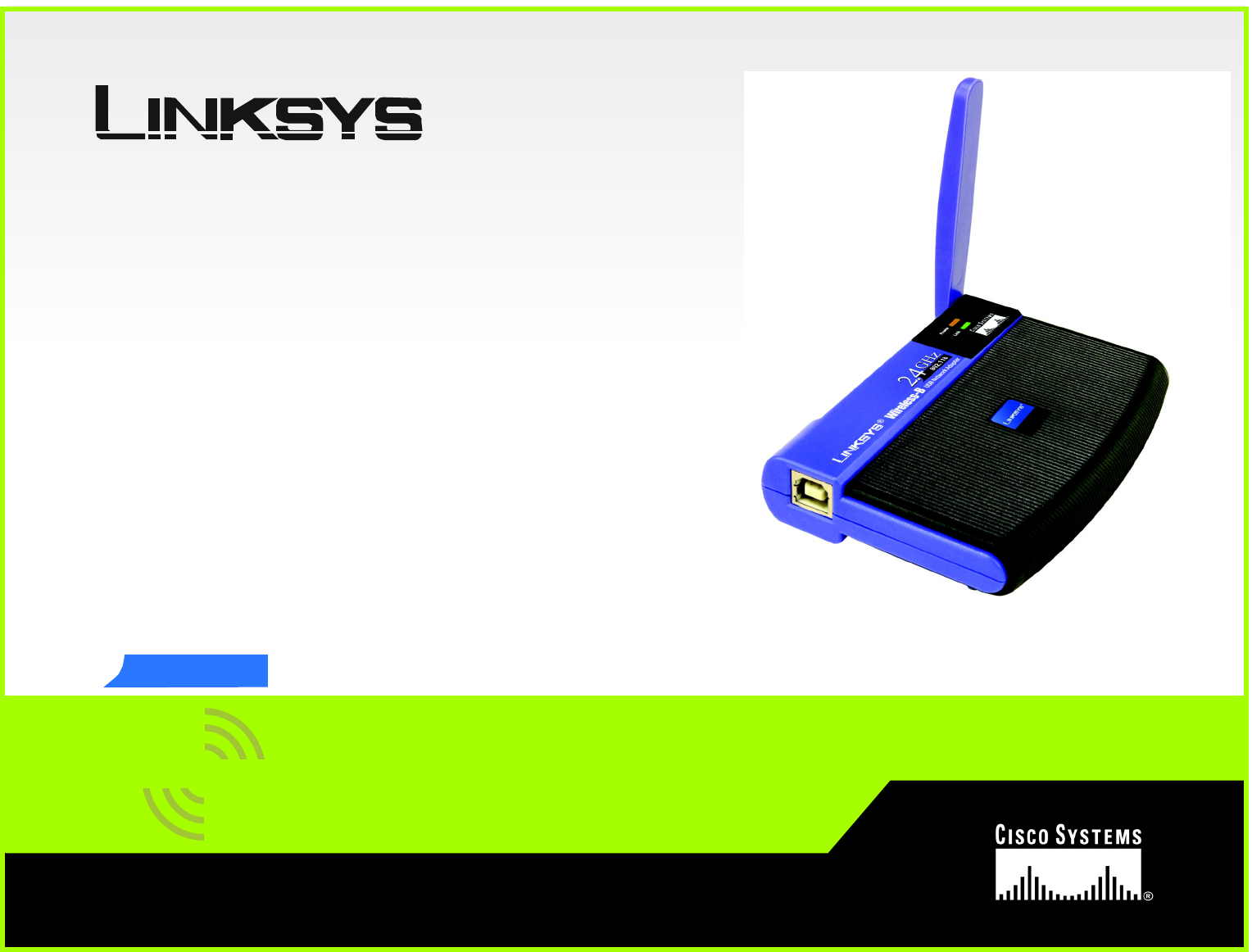
A Division of Cisco Systems, Inc.
®
Model No.
USB Network Adapter
Wireless-B
WUSB11
User Guide
WIRELESS
GHz
2.4
802.11b

Wireless-B USB Network Adapter
Copyright and Trademarks
Specifications are subject to change without notice. Linksys is a registered trademark or trademark of Cisco
Systems, Inc. and/or its affiliates in the U.S. and certain other countries. Copyright © 2003 Cisco Systems, Inc. All
rights reserved. Other brands and product names are trademarks or registered trademarks of their respective
holders.
This User Guide
The User Guide to the Wireless-B USB Network Adapter has been designed to make understanding networking
easier than ever. Look for the following items when reading this guide:
In addition to these symbols, there are definitions for technical terms that are presented like this:
Also, each figure (diagram, screenshot, or other image) is provided with a figure number and description, like
this:
Figure numbers and descriptions can also be found in the "List of Figures" section in the “Table of Contents”.
This exclamation point means there is a Caution or
warning and is something that could damage your
property or the USB Network Adapter.
word: definition.
This checkmark means there is a Note of interest and
is something you should pay special attention to while
using the USB Network Adapter.
This question mark provides you with a reminder about
something you might need to do while using the USB
Figure 0-1: Sample Figure Description
wusb11 v3-UG-31029NC KL

Wireless-B USB Network Adapter
Table of Contents
Chapter 1: Introduction 1
Welcome 1
What’s in this Guide? 2
Chapter 2: Planning your Wireless Network 4
Network Topology 4
Roaming 4
Network Layout 5
Chapter 3: Getting to Know the USB Network Adapter 6
The USB Port 6
The LED Indicators 6
Chapter 4: Software Installation and Configuration for Windows 98SE, Me, and 2000 7
The Installation Procedure 8
Chapter 5: Hardware Installation 11
Connecting the Adapter 11
Using the Adapter’s Wall Mount 13
Chapter 6: Driver Installation and Configuration for Windows XP 15
Windows XP Wireless Zero Configuration 16
Chapter 7: Using the WLAN Monitor for Windows 98SE, Me, and 2000 18
Accessing the WLAN Monitor 18
Link Information 18
Site Survey 20
Profiles 21
Creating a New Profile 23
Appendix A: Troubleshooting 27
Common Problems and Solutions 27
Frequently Asked Questions 28
Appendix B: Wireless Security 31
Security Precautions 31
Security Threats Facing Wireless Networks 31
Appendix C: Windows Help 34
Appendix D: Glossary 35

Wireless-B USB Network Adapter
Appendix E: Specifications 38
Appendix F: Warranty Information 40
Appendix G: Regulatory Information 41
Appendix H: Contact Information 44

Wireless-B USB Network Adapter
List of Figures
Figure 3-1: Back Panel 6
Figure 3-2: Front Panel 6
Figure 4-1: The Setup Wizard’s Welcome screen 7
Figure 4-2: The Setup Wizard’s License Agreement 8
Figure 4-3: The Setup Wizard’s Network Mode screen 8
Figure 4-4: The Setup Wizard’s Wireless Channels screen 9
Figure 4-5: The Setup Wizard’s Finalize Settings screen 9
Figure 4-6: The Setup Wizard’s Congratulations Screen 10
Figure 5-1: How the Adapter connects to your PC 11
Figure 5-2: The Adapter’s USB Port 11
Figure 5-3: A PC’s USB port 11
Figure 5-4: The Adapter’s LEDs 12
Figure 5-5: Positioning the LEDs antenna 12
Figure 5-6: The Adapter’s Wall Mount 13
Figure 5-7: Using the Wall Mount - Step A 13
Figure 5-8: Using the Wall Mount - Step B 14
Figure 5-9: Using the Wall Mount - Step C 14
Figure 6-1: Install Software Automatically 15
Figure 6-2: wizard Finished 15
Figure 6-3: The Zero Configuration Icon 16
Figure 6-4: Zero Configuration Connection without WEP 16
Figure 6-5: Zero Configuration Connection with WEP 17
Figure 6-6: Zero Configuration Active Wireless Connection 17
Figure 7-1: The WLAN Monitor icon 18
Figure 7-2: The Link Information screen 18
Figure 7-3: More Link Information 19
Figure 7-4: Site Survey 20
Figure 7-5: WEP Encryption 20
Figure 7-6: Profiles 21
Figure 7-7: Importing a Profile 22

Wireless-B USB Network Adapter
Figure 7-8: Exporting a Profile 22
Figure 7-9: Creating a New Profile 23
Figure 7-10: Enter Profile Name 23
Figure 7-11: Network Settings for New Profile 24
Figure 7-12: Network Mode for New Profile 24
Figure 7-13: Wireless Channels for New Profile 25
Figure 7-14: Security Settings for New Profile 25
Figure 7-15: Confirm New Settings for New Profile 26
Figure 7-16: Congratulations for New Profile 26

1
Chapter 1: Introduction
Welcome
Wireless-B USB Network Adapter
Chapter 1: Introduction
Welcome
Thank you for choosing the Wireless-B USB Network Adapter. With this Adapter, your wireless networking
experience will be faster and easier than ever.
How does the Adapter do this? Like all wireless products, the Adapter allows for greater range and mobility
within your wireless network. Connecting to your PC via the USB port means that this Adapter leaves the PC’s
slots open for other purposes. This adapter communicates over the 802.11b wireless standard, one of the most
popular wireless standards, to communicate with your network.
But what does all of this mean?
Networks are useful tools for sharing computer resources. You can access one printer from different computers
and access data located on another computer's hard drive. Networks are even used for playing multiplayer video
games. So, networks are not only useful in homes and offices, they can also be fun.
PCs equipped with wireless cards and adapters can communicate without cumbersome cables. By sharing the
same wireless settings, within their transmission radius, they form a wireless network.
Use the instructions in this Guide to help you connect the Access Point, set it up, and configure it to bridge your
different networks. These instructions should be all you need to get the most out of the Access Point.
802.11b: an IEEE wireless networking standard
that specifies a maximum data transfer rate of
11Mbps and an operating frequency of 2.4GHz.
adapter: a device that adds network functionality to your PC.
network: a series of computers or devices
connected for the purpose of data sharing,
storage, and/or transmission between users.

2
Chapter 1: Introduction
What’s in this Guide?
Wireless-B USB Network Adapter
What’s in this Guide?
This user guide covers the steps for setting up and using the Wireless-B USB Network Adapter.
• Chapter 1: Introduction
This chapter describes the Adapter’s applications and this User Guide.
• Chapter 2: Planning Your Wireless Network
This chapter discusses a few of the basics about wireless networking.
• Chapter 3: Getting to Know the Wireless-B USB Network Adapter
This chapter describes the physical features of the Adapter.
• Chapter 4: Software Installation and Configuration for Windows 98SE, Me, and 2000
This chapter instructs you on how to install the Adapter’s Setup Wizard and Configure the Adapter for
Windows 98SE, Me, and 2000.
• Chapter 5: Hardware Installation
This chapter shows you how to connect the Adapter to your PC.
• Chapter 6: Driver Installation and Configuration for Windows XP
This chapter explains how to install the Adapter’s driver and use Windows Zero Configuration.
• Chapter 7: Using the WLAN Monitor for Windows 98SE, Me, and 2000
This chapter show you how to use the Adapter’s WLAN Monitor.
• Appendix A: Troubleshooting
This appendix describes some problems and solutions, as well as frequently asked questions, regarding
installation and use of the Adapter.
• Appendix B: Wireless Security
This appendix discusses security issues regarding wireless networking and measures you can take to help
protect your wireless network.
• Appendix C: Windows Help
This appendix describes how you can use Windows Help for instructions about networking, such as installing
the TCP/IP protocol.
• Appendix D: Glossary
This appendix gives a brief glossary of terms frequently used in networking.

3
Chapter 1: Introduction
What’s in this Guide?
Wireless-B USB Network Adapter
• Appendix E: Specifications
This appendix provides the Adapter’s technical specifications.
• Appendix F: Warranty Information
This appendix supplies the Adapter’s warranty information.
• Appendix G: Regulatory Information
This appendix supplies the Adapter’s regulatory information.
• Appendix H: Contact Information
This appendix provides contact information for a variety of Linksys resources, including Technical Support.

4
Chapter 2: Planning your Wireless Network
Network Topology
Wireless-B USB Network Adapter
Chapter 2: Planning your Wireless Network
Network Topology
A wireless network is a group of computers, each equipped with one wireless adapter. Computers in a wireless
network must be configured to share the same radio channel. Several PCs equipped with wireless cards or
adapters can communicate with one another to form an ad-hoc network.
Linksys wireless adapters also provide users access to a wired network when using an access point or wireless
router. An integrated wireless and wired network is called an infrastructure network. Each wireless PC in an
infrastructure network can talk to any computer in a wired network infrastructure via the access point or wireless
router.
An infrastructure configuration extends the accessibility of a wireless PC to a wired network, and can double the
effective wireless transmission range for two wireless adapter PCs. Since an access point is able to forward data
within a network, the effective transmission range in an infrastructure network can be doubled.
Roaming
Infrastructure mode also supports roaming capabilities for mobile users. Roaming means that you can move your
wireless PC within your network and the access points will pick up the wireless PC's signal, providing that they
both share the same channel and SSID.
Before enabling you consider roaming, choose a feasible radio channel and optimum access point position.
Proper access point positioning combined with a clear radio signal will greatly enhance performance.
infrastructure: a wireless network that is
bridged to a wired network via an access point.
ad-hoc: a group of wireless devices
communicating directly with each other (peer-
to-peer) without the use of an access point.
roaming: the ability to take a wireless device from one
access point's range to another without losing the connection.
ssid: your wireless network's name.
topology: the physical layout of a network.

5
Chapter 2: Planning your Wireless Network
Network Layout
Wireless-B USB Network Adapter
Network Layout
Linksys wireless access points and wireless routers have been designed for use with 802.11a, 802.11b, and
802.11g products. With 802.11g products communicating with the 802.11b standard and some products
incorporating both “a” and “g”, products using these standards can communicate with each other.
Access points and wireless routers are compatible with 802.11a, 802.11b and 802.11g adapters, such at the PC
Cards for your laptop computers, PCI Card for your desktop PC, and USB Adapters for when you want to enjoy
USB connectivity. Wireless products will also communicate with the wireless PrintServer.
When you wish to connect your wired network with your wireless network, network ports on access points and
wireless routers can be connected to any of Linksys's switches or routers.
With these, and many other, Linksys products, your networking options are limitless. Go to the Linksys website at
www.linksys.com for more information about wireless products.
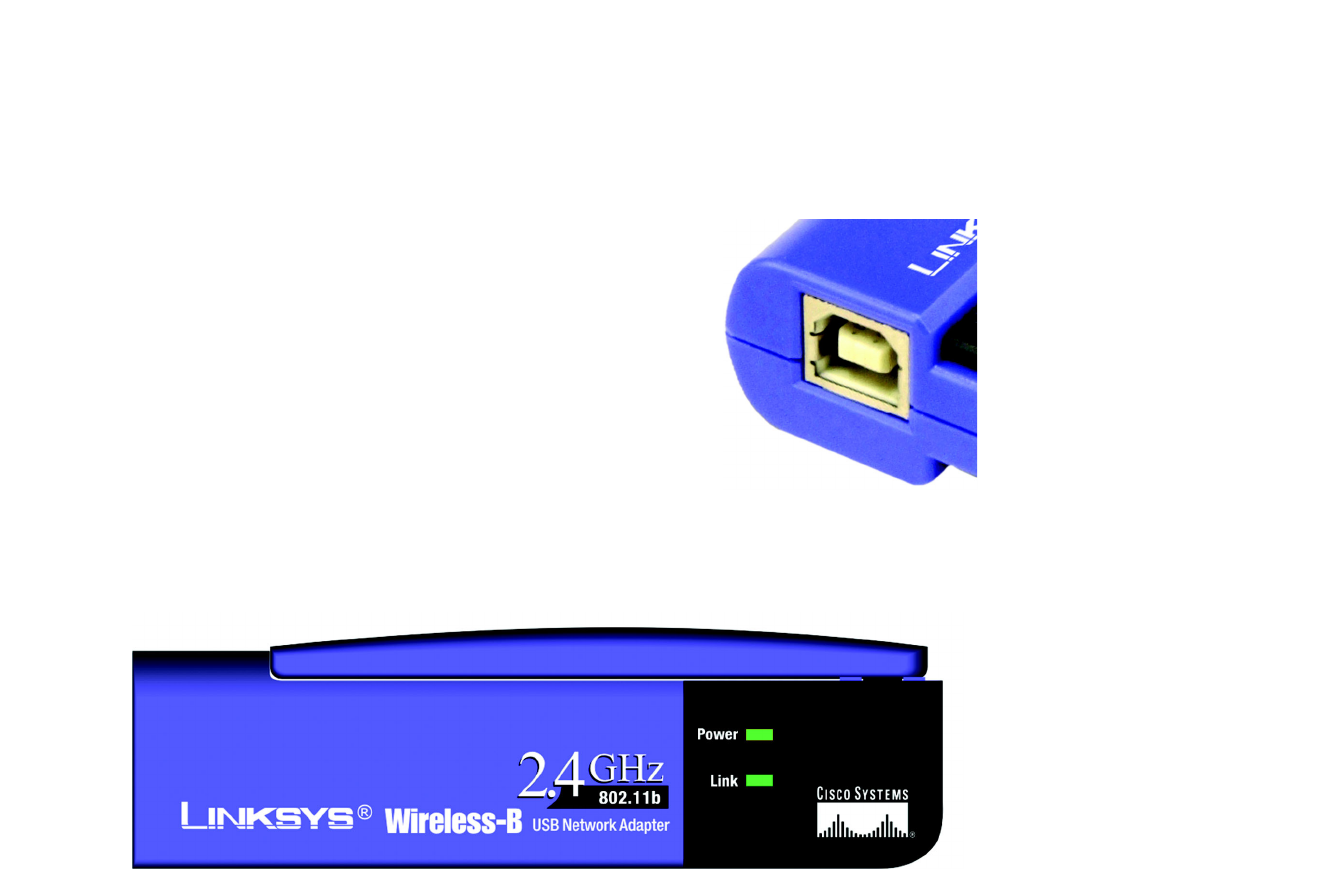
6
Chapter 3: Getting to Know the USB Network Adapter
The USB Port
Wireless-B USB Network Adapter
Chapter 3: Getting to Know the USB Network Adapter
The USB Port
The Adapter’s USB port is located on the side of the Adapter. You will attach
the included USB cable to this port. The other end of the cable will connect to
your PC’s USB port.
The LED Indicators
The Network Adapter's LEDs display information about network activity.
Power Green. The Power LED lights up when the Adapter is powered on.
Link Green. The Link LED lights up when the Adapter has an active connection.
Figure 3-1: Back Panel
Figure 3-2: Front Panel
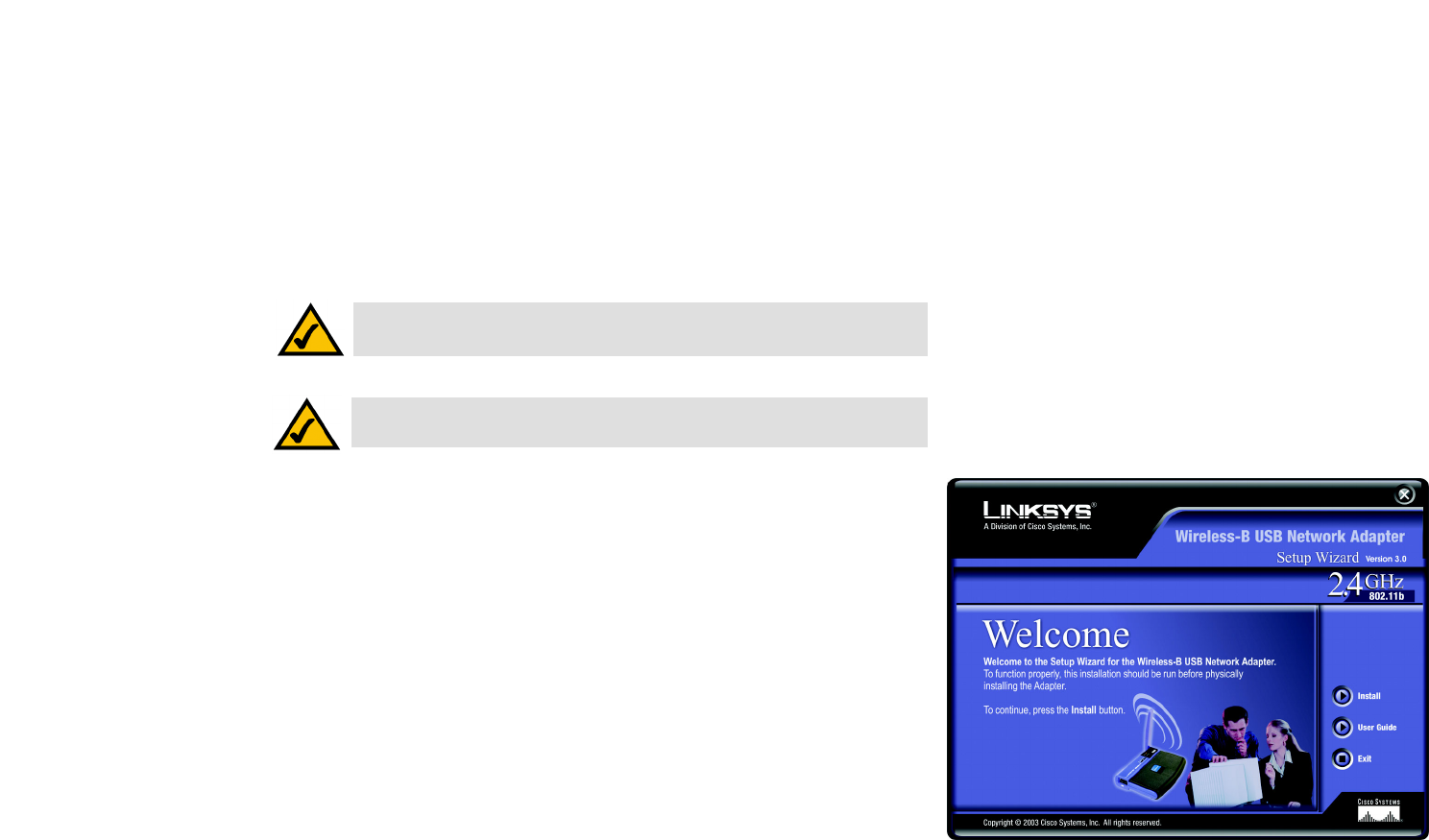
7
Chapter 4: Software Installation and Configuration for Windows 98SE, Me, and 2000
Wireless-B USB Network Adapter
Chapter 4: Software Installation and Configuration for
Windows 98SE, Me, and 2000
The Wireless Wireless-B USB Network Adapter Setup Wizard will guide you through the installation procedure for
Windows 98SE, Me, and 2000. The Setup Wizard will install the WLAN Monitor and driver, as well as configure the
Adapter.
Insert the Setup Wizard CD-ROM into your CD-ROM drive. The Setup Wizard should run automatically,
and the Welcome screen should appear. If it does not, click the Start button and choose Run. In the
field that appears, enter D:\setup.exe (if “D” is the letter of your CD-ROM drive).
On the Welcome screen, you have the following choices:
Install - Click the Install button to begin the software installation process.
User Guide - Click the User Guide button to open the PDF file of this User Guide.
Exit - Click the Exit button to exit the Setup Wizard.
software: instructions for the computer
NOTE: Windows XP Users. Do NOT run the Wireless-B USB Network Adapter
Setup Wizard. Proceed directly to “Chapter 5: Hardware Installation.”
NOTE: Windows 98SE, Me, and 2000 users. You must run the Setup Wizard
to install the software before installing the hardware.
Figure 4-1: The Setup Wizard’s Welcome screen
wlan: a group of computers and associated devices that
communicate with each other wirelessly.
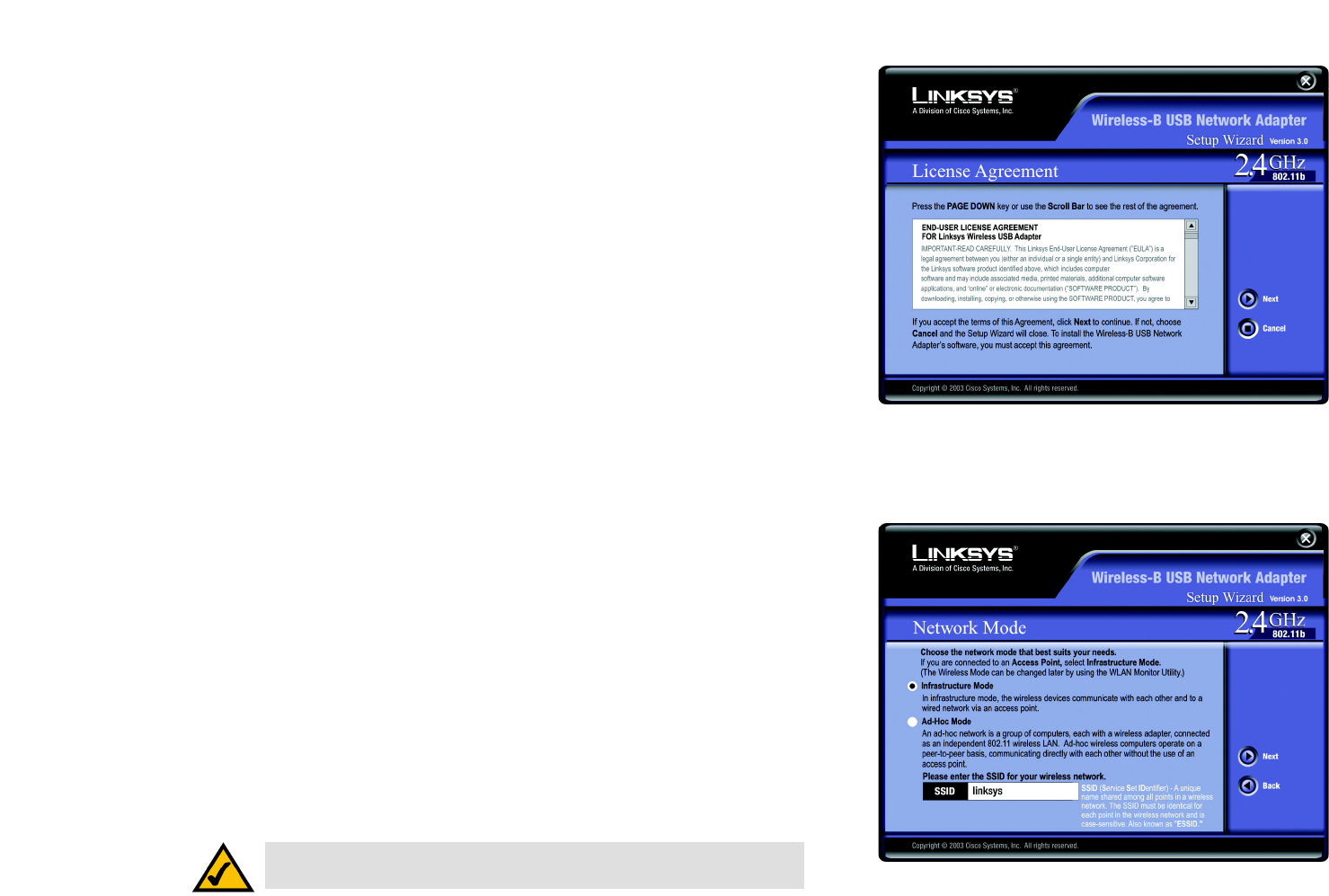
8
Chapter 4: Software Installation and Configuration for Windows 98SE, Me, and 2000
The Installation Procedure
Wireless-B USB Network Adapter
The Installation Procedure
1. To install the Adapter, click the Install button on the Welcome screen.
2. After reading the License Agreement, click the Next button if you agree, or click the Cancel button to end the
installation.
3. The Setup Wizard will ask you to choose a network mode. Click the Infrastructure Mode radio button if you
want your wireless computers to network with computers on your wired network using a wireless access
point. Click the Ad-Hoc Mode radio button if you want multiple wireless computers to network directly with
each other.
In the SSID field, enter the SSID of your wireless network. The SSID must be identical for all devices in the
network. The default setting is linksys (all lowercase). Click the Next button.
Figure 4-2: The Setup Wizard’s License Agreement
Figure 4-3: The Setup Wizard’s Network Mode screen
NOTE: Network SSIDs should be unique to your network and identical for all
devices within the network.
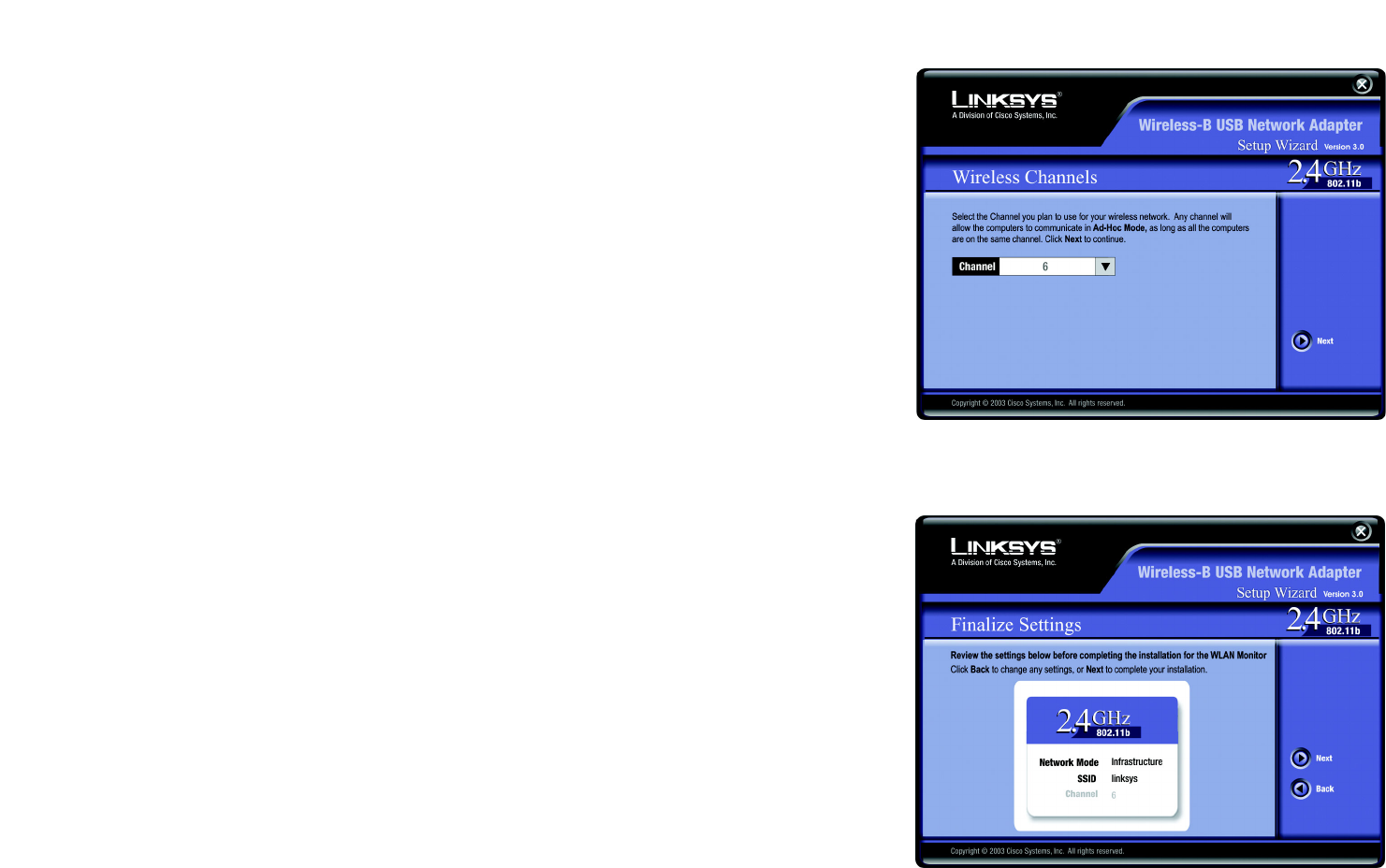
9
Chapter 4: Software Installation and Configuration for Windows 98SE, Me, and 2000
The Installation Procedure
Wireless-B USB Network Adapter
4. If you chose Infrastructure Mode, go to Step 5 now. If you chose Ad-Hoc Mode, select the correct
operating channel for your network. The channel you choose should match the channel set on the other
devices in your wireless network. Then click the Next button.
5. The Setup Wizard will ask you to review your settings before it starts to copy files. Click the Next button to
save these settings, or click the Back button to change any settings.
If you’re using Windows 2000, you may see a Windows Digital Signature warning. As this product has been
tested to work with Windows, you may continue.
Figure 4-4: The Setup Wizard’s Wireless Channels screen
Figure 4-5: The Setup Wizard’s Finalize Settings screen

10
Chapter 4: Software Installation and Configuration for Windows 98SE, Me, and 2000
The Installation Procedure
Wireless-B USB Network Adapter
6. After the software has been successfully installed, the Congratulations screen will appear. Click the Exit
button.
Proceed to “Chapter 5: Hardware Installation.”
Figure 4-6: The Setup Wizard’s Congratulations Screen
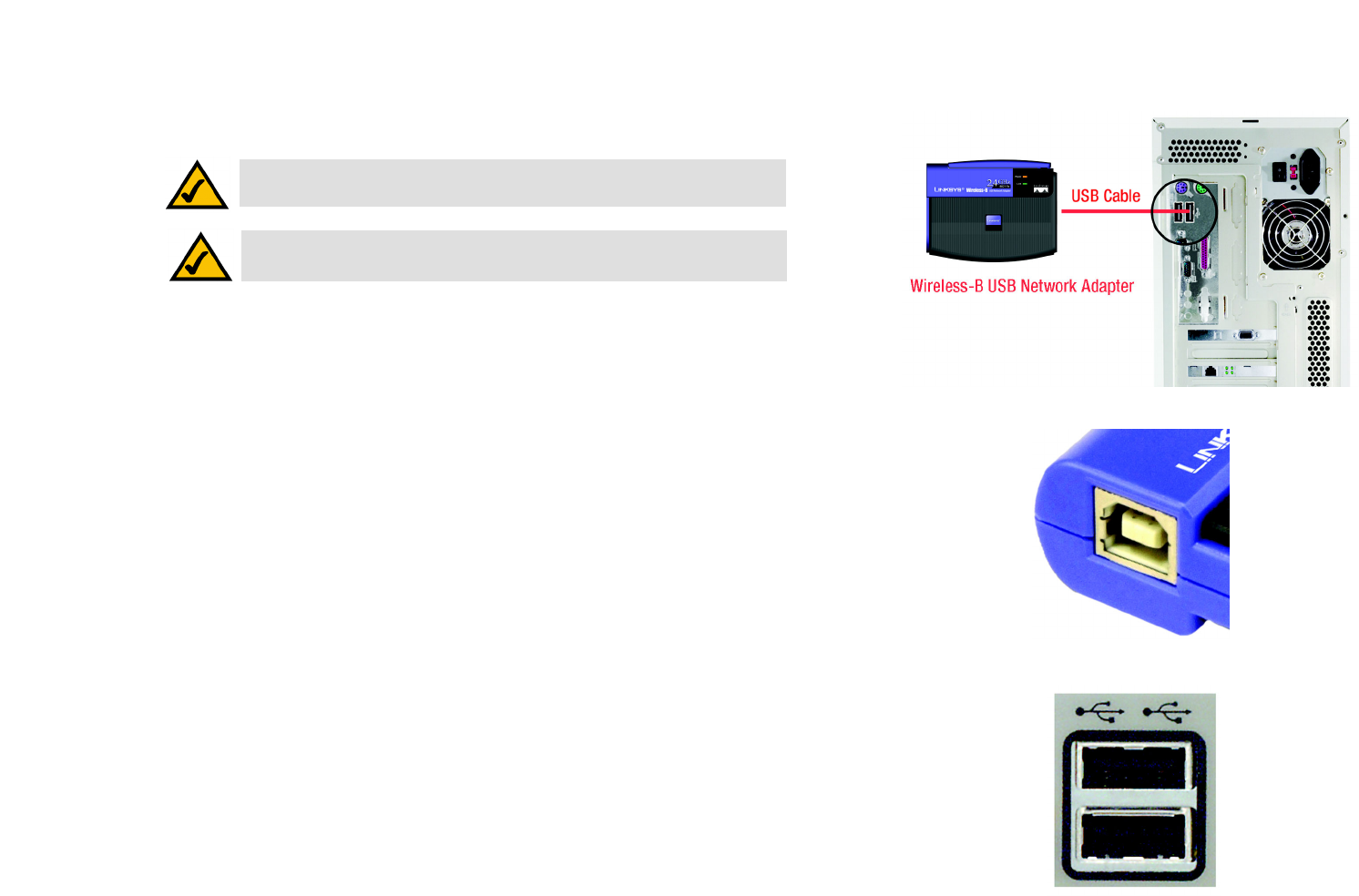
11
Chapter 5: Hardware Installation
Connecting the Adapter
Wireless-B USB Notebook Adapter
Chapter 5: Hardware Installation
Connecting the Adapter
1. The Adapter comes with the USB cable you will use to connect the Adapter to your PC.
Connect one end of the USB cable to the USB port of the Adapter.
Connect the other end of the USB cable to one of the USB ports on your computer.
Figure 5-2: The Adapter’s USB Port
Figure 5-1: How the Adapter connects to your PC
Figure 5-3: A PC’s USB port
NOTE: Windows XP Users. You must install the Adapter’s hardware before
installing the software.
NOTE: Windows 98SE, Me, and 2000 users. You must run the Setup Wizard
to install the software before installing the hardware.
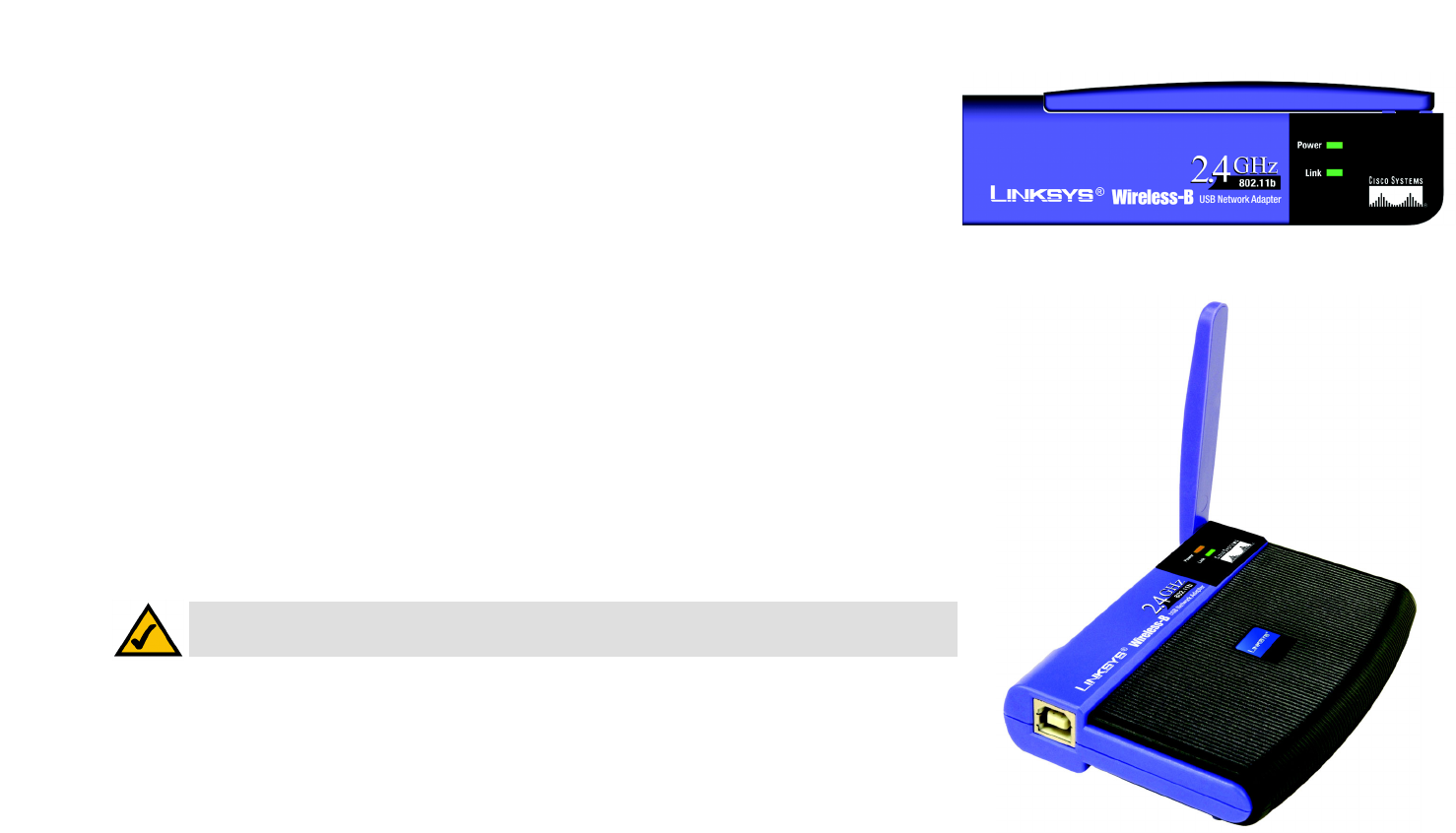
12
Chapter 5: Hardware Installation
Connecting the Adapter
Wireless-B USB Notebook Adapter
2. The Power LED should light up when the Adapter is plugged in. (Make sure your PC is powered on.)
Raise the antenna. Make sure the antenna is positioned straight up into the air, at a 90º angle from the Adapter.
This will ensure optimum wireless operating range and performance.
If your PC is running Windows XP, proceed to “Chapter 6: Driver Installation and Configuration for
Windows XP.”
If your PC is running Windows 98SE, Me, or 2000, the installation of the Wireless-B USB Network
Adapter is complete. If you want to check the link information, search for available wireless networks,
or make additional configuration changes, proceed to “Chapter 7: Using the WLAN Monitor for Windows
98SE, Me, and 2000.”
Figure 5-4: The Adapter’s LEDs
Figure 5-5: Positioning the LEDs antenna
NOTE: If you want to attach the Adapter onto your wall, go to the next section, “Using the Adapter’s
Wall Mount,” before proceeding to the appropriate chapter for your PC’s operating system.
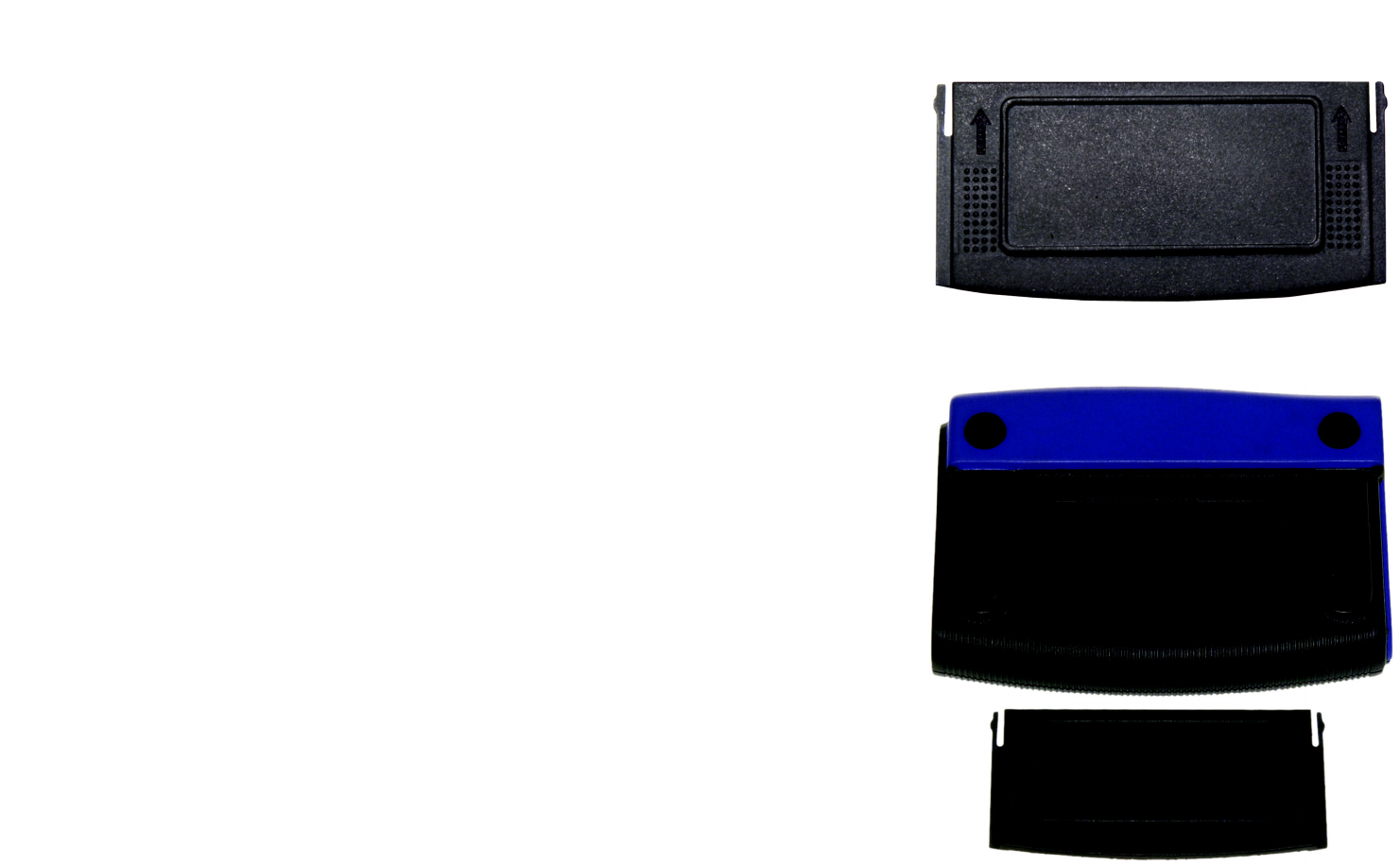
13
Chapter 5: Hardware Installation
Using the Adapter’s Wall Mount
Wireless-B USB Notebook Adapter
Using the Adapter’s Wall Mount
The Adapter’s Wall Mount allows you to easily attach the Adapter onto your wall for better reception and more
convenient placement.
1. Attach the separate adhesive strip of velcro to the wall where you will be mounting the Adapter.
2. To attach the Wall Mount to the Adapter, slide the Wall Mount into the grooves on the back panel of the
Adapter, as shown in Steps A, B, and C.
Figure 5-6: The Adapter’s Wall Mount
Figure 5-7: Using the Wall Mount - Step A
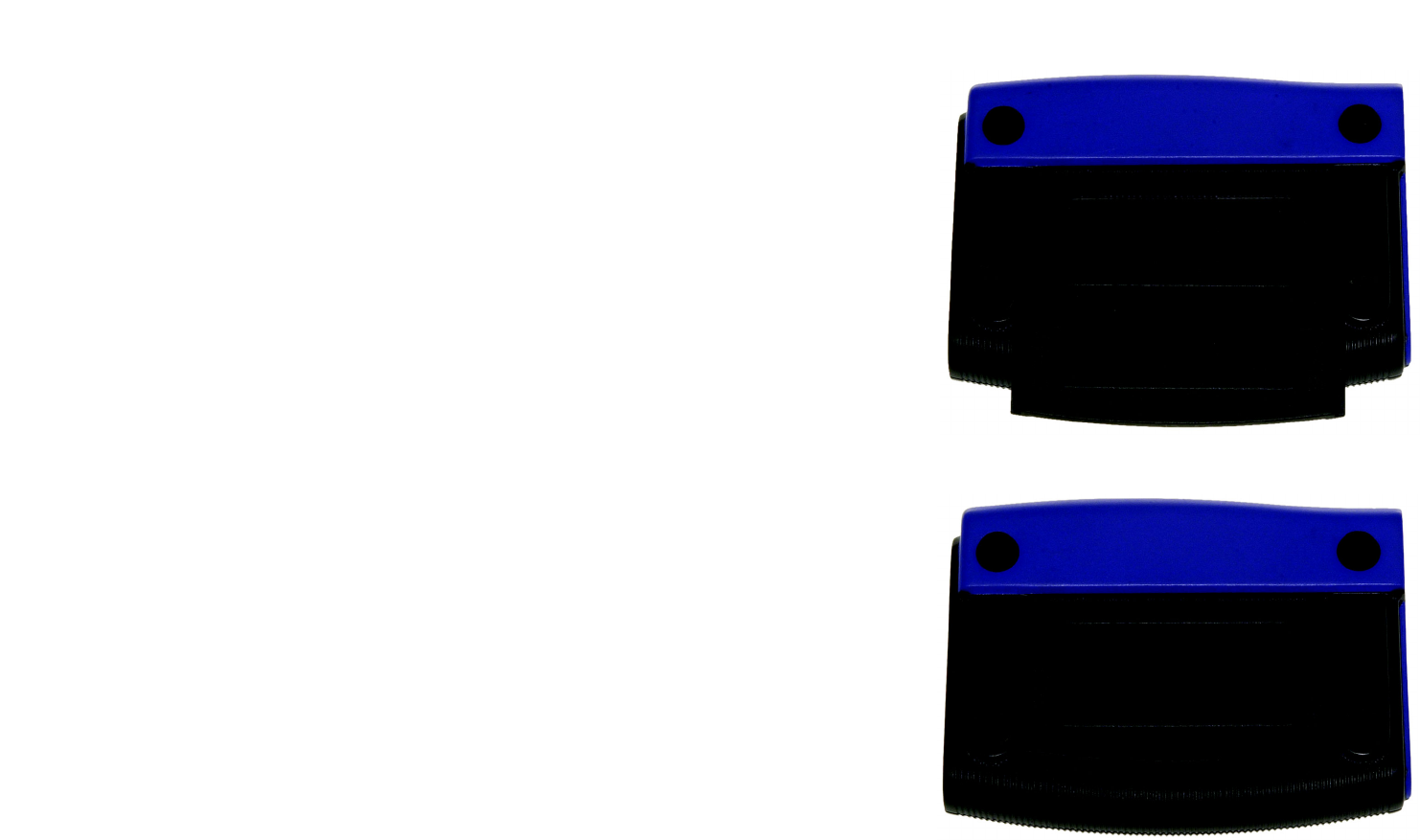
14
Chapter 5: Hardware Installation
Using the Adapter’s Wall Mount
Wireless-B USB Notebook Adapter
3. Using the velcro strip on the Adapter’s Wall Mount, attach the Adapter to the velcro strip on your wall.
If your PC is running Windows XP, proceed to “Chapter 6: Driver Installation and Configuration for
Windows XP.”
If your PC is running Windows 98SE, Me, or 2000, the installation of the Wireless-B USB Network
Adapter is complete. If you want to check the link information, search for available wireless networks,
or make additional configuration changes, proceed to “Chapter 7: Using the WLAN Monitor for Windows
98SE, Me, and 2000.”
Figure 5-9: Using the Wall Mount - Step C
Figure 5-8: Using the Wall Mount - Step B